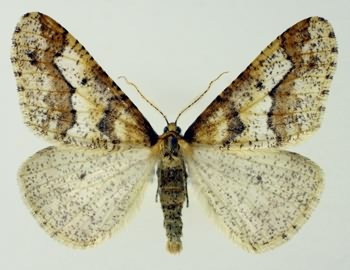Pests
Erannis defoliaria Clerck - Mottled Umber
Systematic position.
Class Insecta, order Lepidoptera, family Geometridae, subfamily Ennominae, genus Erannis.Synonym.
Hybernia defoliaria Cl.Biological group.
Polyphagous pest of fruit and berry cultures.Morphology and biology.
Sexual dimorphism present. Male forewings light yellow, with 2 dark bent cross lines bordering a median light spot; a black spot in the center (wingspan 30-35 mm). Hindwings white-yellow with a spot, covered with dark brown pollen. Coloring rather variable. Female is wingless, yellowish, with black spots along back and venter. Egg about 1 mm in length. Caterpillar brownish-red, with a double line along back and with a yellow lateral stripe; ventrum light. Pupa 10-15 mm in length, dark brown. Eggs overwinter. Females are located on branches and tree trunks, laying 200 to 800 eggs on tree branches at buds and internodes, in bark cracks, one by one or by groups of 2 to 25 eggs.Distribution.
The species inhabits Western, Middle, and Southern Europe; Iceland, Northern Iran. In the former USSR, it is distributed in the European part including Baltic States, Byelorussia, Ukraine (including Crimea), and Northern Caucasus; in Transcaucasia, Urals, Kazakhstan, Kyrgyzstan, Tajikistan, Siberia.Ecology.
Monovoltine species. Caterpillars develop from the end of April until mid-June. Pupation occurs in June, pupae reside in ground the entire summer. Males fly at twilight and at night from the middle or end of September until the beginning of November (in the south, until the end of December or beginning of January), which is 10-15 days earlier than flight of Operophthera brumata.Economic significance.
Caterpillars damage fruiters (apple, pear, cherry, sweet cherry, apricot, cherry plum), dogrose, mountain ash, hawthorn, sloe, walnut, hazel, as well as oak, hornbeam, beech, elm, maple, linden, birch, willow, and bilberry. In the beginning, they eat buds and ovaries and pierce leaves, and later they completely eat leaf plates except main veins. In the middle of outbreaks they completely strip trees. Control measures are as follows. Agronomical ones: summer interrow treatment of ground in gardens in order to destroy pupae, application of sticky belts in small holdings and collective orchards. Biological ones: application of microbiological preparations during bud blossoming (at daily average temperature 15°C and higher). Chemical ones: insecticide treatment of fruiters before flowering in order to kill eggs and caterpillars. Sex pheromone is known.Reference citations:
Milyanovskii, E.S. 1974. Family Geometridae. In: Vasil.ev, V.P., ed. Pests of agricultural crops and forest plantations. V.2. Arthropods. Kiev: Urozhai, p. 343-352 (in Russian).Mironov, V.G. 1999. Family Geometridae. In: Kuznetsov, V.I., ed. Insects and mites . pests of agricultural crops. Lepidoptera. St. Petersburg: Nauka. V. 3(2). p. 254-273 (in Russian).
© Grichanov I.Ya., Ovsyannikova E.I.


